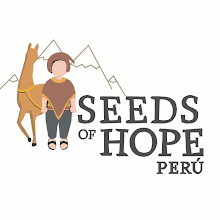Having just finished a fairly intensive degree I'd decided that it would be good for me to take a short break to practice Spanish, which I'd been learning on and off over the last several years. Instead of travelling aimlessly, looking to find myself I decided to be useful and volunteer, perhaps teaching and using my high level of Maths training. Arriving in Huaraz at Seeds I expected that I would just be spending my days with the kids, teaching Maths or English. I never expected that after school was finished I would be giving and attending cooking classes with the local Peruvians and other international volunteers.
Seeds offers English classes 4 nights a week to adults which is a great way for the volunteers to meet the locals. Conversations are often in English, Spanish and Spanglish which offers good opportunities to practice the language. The classes happen in the evenings, after school, so the topic of conversation among the hungry students often turns to food. During a couple of classes we made ourselves so hungry that we went out walking around Huaraz to buy fresh bread and picarones (Peruvian doughnuts in syrup).
I happened to be at Seeds during Thanksgiving so the American volunteers suggested we cook a thanksgiving dinner with the students from the English class, ensuring of course that the conversation was (mainly) in English since it was of course still an English lesson. Although the menu planning was led by the Americans, since no one else in their right mind would think to combine camote (sweet potato) with marshmallows, most of the cooking was done by the locals and an Englishman. The volunteers went shopping at lunchtime to the local markets, with one of the students, to hunt for bargains. Although we struggled to find cranberries (arandanos rojos), despite coming close with arandanos (blueberries) and or cherries, we did find a turkey and most of the trimmings. We hit a slight problem with the Seed's oven which didn't have a temperature control and was a bit small for the turkey but were rescued, once again by one of the locals who lived nearby and who's oven we borrowed before carrying the hot turkey a few blocks, just before dinner.
After the success of the thanksgiving dinner, the Peruvians riposted with a couple more Peruvian meals including aji gallina (chicken with yellow chilli and rice), papas rellenas (stuffed, fried potato balls), papas a la Huancaina (sliced potatoes with yellow chilli cream) and yuca frita (fried cassava, like potato but more fibrous) with a red pepper cream. While there was of course a chef-in-charge (thanks Sergio!), everyone joined in with the cooking offering contrasting advice on the correct method or the correct type of potato to use (Peru has over 4000 (yes, thousand) varieties of potato in common use, and God help you if you serve the wrong sort for that dish to a Peruvian).
Since returning home a few weeks ago I have already made aji gallina and pisco sours to try to revive some of those experiences. However it wasn't quite the same without the market shopping experience or the friendly sword fights with spatulas in the kitchen with Sergio. I'm sure I will be back in the next couple of years to buy some more ingredients and learn more recipes!










